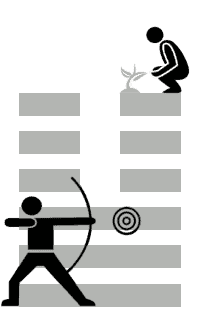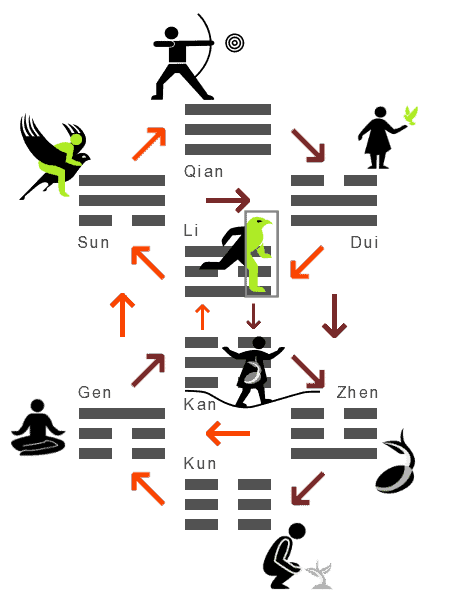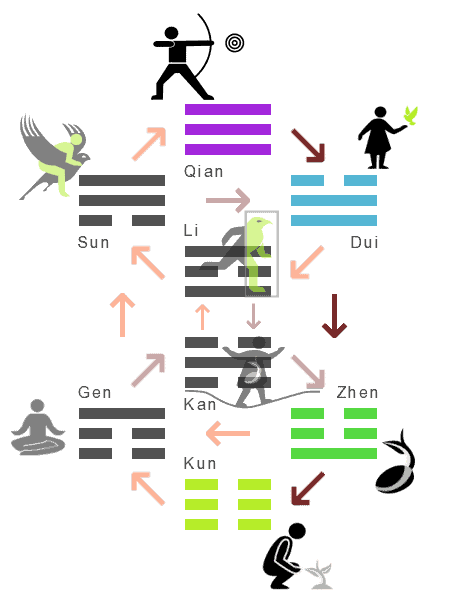Since I started to work more intensively on deciphering the hexagrams, one of the most important sources that showed me the way was the quote from Wang Bi in which he talks about the fish trap. He says:
The images stem from the ideas.… The images are the trap for the ideas… once you have captured the ideas, you can forget the images. Wang Bi (from Zimmermann 2007, 64 and note 14)

The hexagrams of the I Ching also convey ideas, namely ideas of how to ideally deal with a situation. The ideas presented by the hexagrams are abstract and universal. But they can be described with words, they can be transformed into a kind of instruction manual.
Basically, the whole thing is not unlike a cooking recipe: there are more or less abstract instructions and, if you’re lucky, a few illustrating images that make the procedure clearer.
However, the image that illustrates an idea should definitely be born out of the idea it refers to. A recipe that is decoratively illustrated but none of the images have anything to do with the dish to be cooked is confusing. The image should express the idea and make it easier for the user to access the abstract instruction’s contents. And once the user has grasped the idea/content, he no longer needs the image.

Having said all that, I started working with pictograms on no2DO in 2013. My aim was to symbolize the meaning and energy of the trigrams, the core elements that form a hexagram, in a memorable and intuitive way. What I wanted to achieve is that the user can recognize the dynamics of a hexagram – i.e. the interplay of the energies it contains – at a glance without every time having to look up the names of the trigrams or memorize their meanings.
And so today, pictograms ideally make something visible that would otherwise only exist as an abstract idea. They condense many explanatory words into a single, powerful image. And this image makes it easier to grasp the underlying idea without having to remember the many descriptive words.
Trigrams illustrated with Pictograms
The symbols I chose for the eight trigrams in 2013, which I feel illustrate the ideas behind the trigrams, stem from my artistic intuition.
 Kun, the Earth Kun, the Earth |  Dui, the Lake Dui, the Lake |  Li, the Fire Li, the Fire |  Sun, the Wind/Tree Sun, the Wind/Tree |
 Qian, the Heaven Qian, the Heaven |  Zhen, the Thunder Zhen, the Thunder |  Gen, the Mountain Gen, the Mountain |  Kan, the Water Kan, the Water |
At the time, I chose the gardener, the girl feeding pigeons, the phoenix, the bird rider, the archer, the sprouting seedling, the meditator and someone crossing an abyss – and my choice has remained the same ever since. Even when I revised the pictograms in 2024 together with a talented designer, this original symbolism was retained. We redesigned the pictograms visually, but deliberately retained the essence that these symbols have carried since 2013.
One question we asked ourselves during the 2024 redesign process was whether it would make sense to provide not only the upper and lower trigrams of a hexagram, but also the two core characters with matching pictograms. After all, two energies do not simply collide in a hexagram, but the hexagram shows how the lower trigram transforms into the upper one, a transition that takes place in the two core characters.

In the end, however, we decided not to illustrate the core characters as well. This is because a hexagram with four pictograms (lower trigram [in the case of hexagramm 11 – peace this would be Qian, the Heaven], first core character [Dui, the Lake], second core character [Zhen, the Thunder], upper trigram [Kun, the Earth]) would have been visually overloaded and therefore confusing.
Pictograms within the Basic Matrix
As a mental aid for interested users of no2DO, not only individual hexagrams but also the basic matrix of the trigrams (see interpretation model) could now be illustrated with pictograms:

For hexagram 11 – peace, this results in the following representation:

The question now is whether a presentation using pictograms actually makes it easier for the user to access the meaning of a hexagram and its energies. Or, to put it another way: can a user immediately recognize the interplay of a hexagram’s energies thanks to the pictograms and thus – at a glance! – have an basic idea of the path that the hexagram suggests?
Regardless of the answer in each individual case, one thing is certain: the use of pictograms can be seen as a reference and a Western approximation to the origins of the Book of Changes. After all, the I Ching was originally written in Chinese, a language in which (written) symbols play a key role.
So let us keep playing.
And let us keep examining this way of interpreting the I Ching.
Until one hopeful day we can let go of the fish trap.
Because we have caught the fish.
Bibliography
— Zimmermann, Georg. 2007. I Ging – Das Buch der Wandlungen. Düsseldorf: Patmos.


